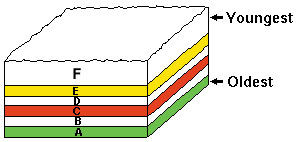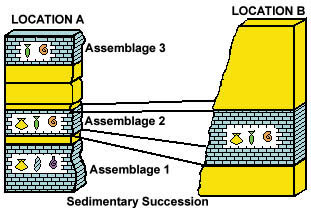
Relative Age Determination
superposition |
Superposition of rock units is a very simple and straightforward method of relative age determination. The principle states that in a sequence of undeformed sedimentary rocks the oldest beds are at the bottom and the youngest ones are at the top. Underlying assumptions are 1) that layers were originally deposited horizontally, 2) and that beds are not overturned (sedimentary structures can be used to dermine whether a sedimentary succession is overturned or not). |
faunal succession
|
Faunal Succession is based on the observation that animals and animal communities that are preserved in sedimentary rocks change noticeably as geologic time passes (evolution). It was first recognized by William Smith, a British Surveyor, who while working on open cuts of canals, railroads, and roads, noticed that the fossils change systematically from the older towards the younger rocks. This principle has in the meanwhile been established to be true for all sediments worldwide, and is the basis of worldwide correlation of sedimentary rock units and one of the underpinnings of the theory of evolution. The image at left illustrates faunal succession. In location A we have rock layers that successively have different types and combinations (assemblages) of fossils. If in location B we find the same fossil assemblage (Assemblage 2) in a rock unit, we may assume that they are of essentially the same age as in location A. |
crosscutting |
Crosscutting Relations are those where one rock literally cuts across another, such as for example when igneous dikes and sills are emplaced in fractures within a pile of sedimentary rocks (see picture at left). Obviously, the sedimentary rocks had to be there prior to emplacement of the igneous rocks, and thus they are older than the igneous rocks. Conversely, the igneous rocks are younger than the sedimentary rocks. Other examples of cross crutting relationships can be related to faults (fault has to be younger than the rock it is found in) and unconformities (see below). |
inclusion |
Inclusions of one rock in another are a further way of determining relative age relationships. In the block diagram at left we see sediment layers that contain pebbles/fragments of the underlying rock units. Inclusions are always older than the rock they are found in. Even if we did not see the igneous and metamorphic rocks in surface exposures, the fact that they occur in the (brownish) sediment unit indicates the presence of older ingneous and metamoprhic rocks that supply material to that unit. |
| In another example: lets assume that we have outcrops of a granite with very distinct texture in one area, and a sedimentary sequence close by, but no direct physical contact between the two rock units. If pebbles of this granite are found in the sedimentary sequence, then the granite must be older than the sediments. If on the other hand inclusions of sediment are found in the granite, then the granite intruded these sediments and is therefore younger. | |